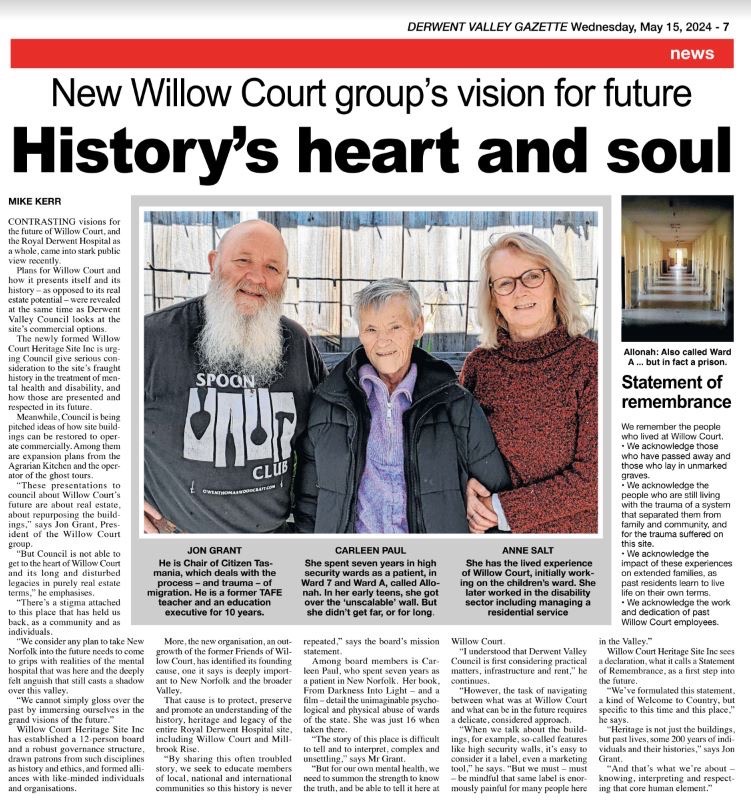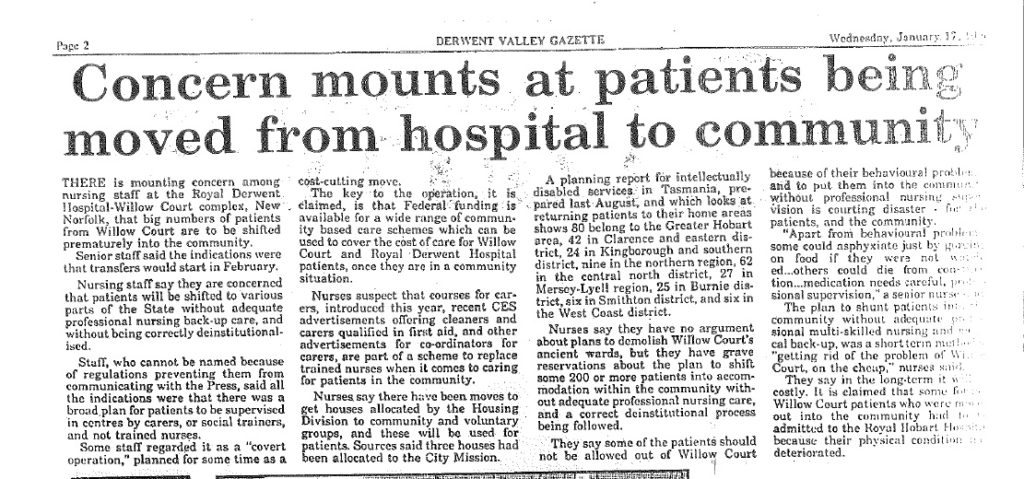Tonight there will be a number of motions put to the Derwent Valley Council meeting, which will be held at the Granton Hall. This has been the biggest activity by the owner of the site for near 3.5 years.
The local media in the Derwent Valley recently reported on one motion which also left out some important facts which created a lot of negative discussion and personal attacks on social media. Two other positive motions were not reported on.
Also on the agenda was a (workshop presentation 6 September) by representatives of Crusader Homes, while many locals may know who this group are, most people wouldn’t know that they are the group who have put a unsolicited expression of interest to Council to develop the Council owned area (excluding the Barracks) into the New Norfolk Rum Distillery.
Also the Agrarian Kitchen have proposed an expansion and relocation of their Lachlan based Cooking School and Garden to the Willow Court site.
Motion number 1:
7.2 Cr Salt – Willow Court Barracks Precinct – Conservation Management Plan
That the Council consider seeking expert heritage advice and associated funding to develop an over- arching Conservation Management Plan (CMP) for the Willow Court Barracks Precinct. The purpose of this CMP is to provide Council with a long term framework for the effective use, development and management of the Willow Court Barracks Precinct, particularly in relation to conserving its historic cultural heritage values.
Rationale
Currently Council has CMPs for individual buildings within the Barracks precinct, but does not have an overarching CMP that encompasses the cultural significance of the Barracks precinct; or policies to guide decision making appropriate to the significance of the site.
The lack of an over arching CMP and associated policies has impacted on successive Councils long term development plans for Willow Court, and is a major factor in Council’s inability to secure loans to continue conservation and development.
Should a future successful application for National Heritage Listing be made for Willow Court, Council will be subject to the National Heritage Management Principles that would
encompass existing overarching Conservation Management Plans.
Motion number 2:
7.3 Cr Salt – Moratorium on Expressions of Interest for Willow Court
That the Council consider a 120 day moratorium on all Expressions of Interest to enable FoWC to develop a structure plan to meet Councils recommendation in the letter dated 9 July. Council has accepted FoWC EoI with a recommendation to develop a structure or group to prepare detailed plans to be included in the 2019/20 budget (FoWC letter dated 6 September below).
Rationale:
FoWC have made significant progress on developing a group to prepare a detailed plan, and will have a plan prepared within the time frame requested.
The FoWC have undertaken initial research from which it has been discovered a significant amount of work was undertaken between 2002 and 2010 by Valley Vision, and in 2014 by the Willow Court Conservation Committee to redevelop and reactivate the site, and which all indicate substantial expenditure by DVC to achieve these ends. This substantial amount of work appears to have been mothballed by successive Councils, as no reference to any of it can be found in Council minutes after August 2014, and some current Councillors have indicated they are not aware of the extent of the work.
The work referred to include a Visitor Services Project that aimed to establish a world class
fee paying, sustainable and vibrant visitor experience with the themes Life Behind the Wall and Art Behind the Wall. The themes were developed and tested by leading tourism and marketing consultants, the process included input from both the Derwent Valley community and the wider Tasmanian and interstate market.
Plans were completed for infrastructure, interpretation, brand, marketing, business, art and object management including a curatorial program, building stabilization and re-use, building fabric, landscape, parking, perimeter wall stabilization and site security.
Examples supporting the viability of the visitor experience include a successful exhibition that was held in The Barracks building as part of the 2009 10 Days on the Island Festival which drew over 900 visitors, and the Dark Mofo event in 2016.
Motion number 3:
7.4 Cr Salt – Willow Court Opening Fee
That the Council considers removing the $110 Willow Court opening fee when the site is
opened by Friends of Willow Court volunteers for individual and group tours, and events;
but retain the current entry fee of $6.00 that goes into the DVC Willow Court account.
Rationale
The Facilities Fee Policy was developed in 2016, with the Opening Fee implemented to cover costs of DVC staff opening Willow Court for events and individuals, and small groups, although it now seems it was an oversight that application of the $110 opening fee may be considered as a deterrent to some people who do not have the financial means to access the site over those who do.
The rationale for this request is that FoWC was unsuccessful in receiving a grant from Council to assist in covering the costs involved to develop materials used for displays and tours; and that Council staff have not been required to open the site since April.
With the establishment of the FoWC Calendar of Events and Facebook page, requests to
access the site have been received by the Committee, and it is expected they will increase.
Request include a visiting archaeologist and PHD student (Eleanor Casella letter below), and a Senior Psychiatric Clinician originally from the UK, seniors groups, and TAFE, in addition to the groups who attend the monthly open days, and Heritage Month event.
To date the Council has waived fees for some events, and the fees were not charged for the
other private tours as it was understood the fee did not apply due to the site being opened
by volunteers, not Council staff. The $6 pp entry fee is charged for all events and site visits.
Full details of the full agenda are HERE



